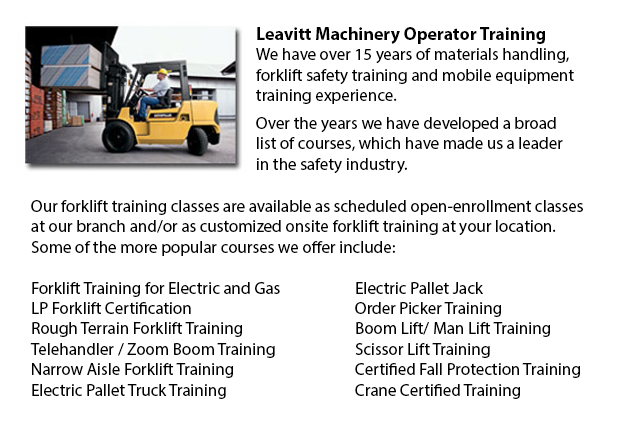
Forklift Training Schools Richmond Hill - Forklift Training Schools - For The Protection Of Your Workers
Are you looking for a job as a forklift driver? Our regulatory-compliant mobile equipment operator training offers instruction in types of forklifts, pre-shift check, fuel kinds and dealing with fuels, and safe operation of a forklift. Hands-on, practical training assists people participating in acquiring essential operational skills. Program content includes existing regulations governing the utilization of lift trucks. Our proven forklift Schools are intended to offer training on these kinds of trucks: powered pallet truck, narrow isle forklift and counterbalanced forklift.
Do not lower or raise the fork while the forklift is traveling. A load should not extend higher than the backrest due to the risk of the load sliding back toward the operator. Inspect for overhead obstructions and make certain there is plenty of clearance prior to lifting a load. Stay away from overhead power lines. Once the load is lifted straight up, tilt it slightly back.
When the load is lifted the forklift will be less steady. Make certain that no pedestrians cross underneath the elevated fork. The operator must never leave the forklift while the load is lifted.
When handling pallets, forks should be level and high enough to go into the pallet and extend all the way beneath the load. The fork's width should provide equal weight distribution.
Before loading or unloading the truck, chock the wheels and set the brakes. Floors must be strong enough to support the weight of the load and the forklift combined. Fixed jacks could be installed in order to support a semi-trailer which is not attached to a tractor. The entrance door height should clear the height of the forklift by a minimum of 5 cm. Edges of rail cars, ramps and docks must be marked and avoid them.
-
Scissor Lift Certification Richmond Hill
Scissor Lift Certification Richmond Hill - Scissor lift platforms are utilized at work sites in order to allow tradespeople - like for example welders, masons and iron workers - to reach their work. Operating a scissor lift platform is usually second... More -
Narrow Aisle Forklift / Order Picker Training / Electric Pallet Jack / Electric Pallet Truck Training in Richmond Hill
A pallet jack is a model of equipment specialized in the transporting of pallets of many dimensions and weights. They might be utilized as an appendage for lift trucks, cranes and other types of heavy machinery or be used on their own. Pallet jacks a... More -
Heavy Equipment Operator Certification Richmond Hill
Heavy Equipment Operator Certification Richmond Hill - The heavy equipment operator is a person who manipulates the controls and drives various kinds of big machinery. Heavy machinery is most frequently used on construction sites in order to deliver... More -
Loader Training Richmond Hill
Loader Training Richmond Hill - Why You Must Finish A Loader Training Course - Individuals wanting work in businesses that use lift trucks must undergo a Loader Training program prior to becoming a certified operator of a lift truck. There are lots o... More -
Manlift Training Richmond Hill
Manlift Training Richmond Hill - Various manlift training programs consist of the review and content of manlift devices. An important part of the course is the practicum where students show their knowledge and practical ability to safely operate a ma... More -
Fall Protection Training in Richmond Hill
There are many injuries at work associated to falling and a lot of fall-related deaths reported every year. Most of these instances could have been prevented with better training, better measures in place, and by correctly equipping personnel before... More -
Wheel Loader Training Richmond Hill
Wheel Loader Training Richmond Hill - Commonly, the various kinds of heavy equipment training are classed into 2 categories of machinery: those which have rubber tires and tracked vehicles. Tracked vehicles consist of items like cranes, bulldozers an... More -
Forklift Certification Schools Richmond Hill
Forklift Certification Schools Richmond Hill - Forklift Certification is mandatory in North America. Hence, forklift training programs are important both for companies and for people seeking jobs in industries as forklift operators. Forklift training... More

Forklift Training Richmond Hill
TOLL FREE: 1-888-254-6157
Richmond Hill, Ontario
forklifttrainingrichmondhill.com
Email Us
About Us


